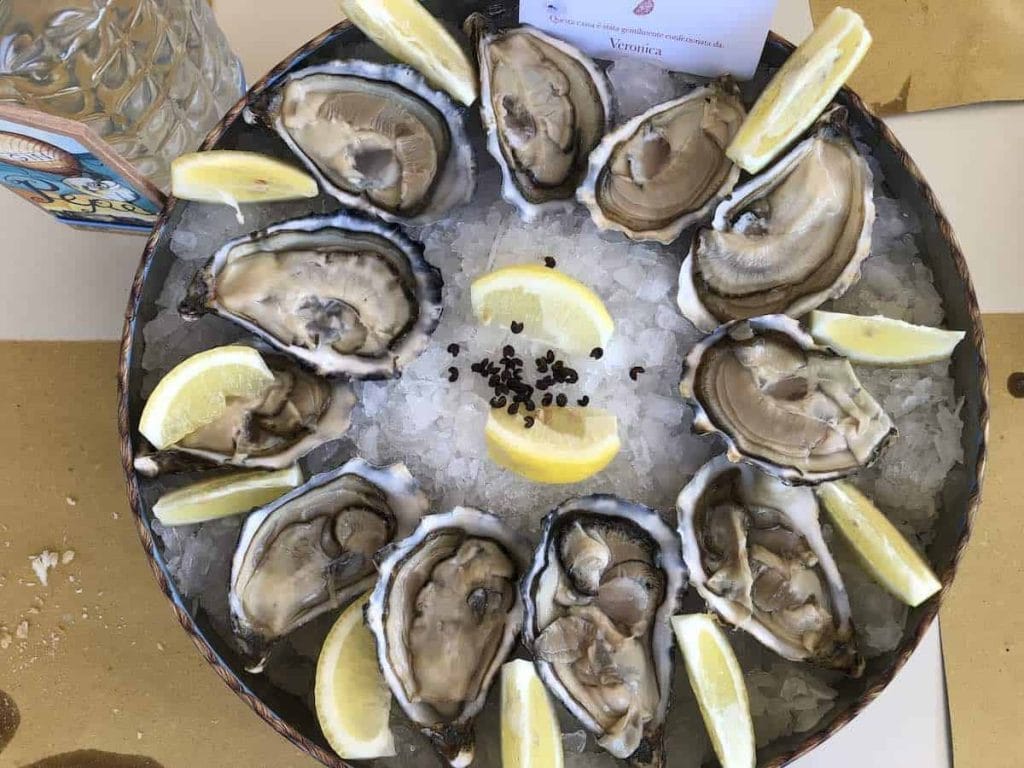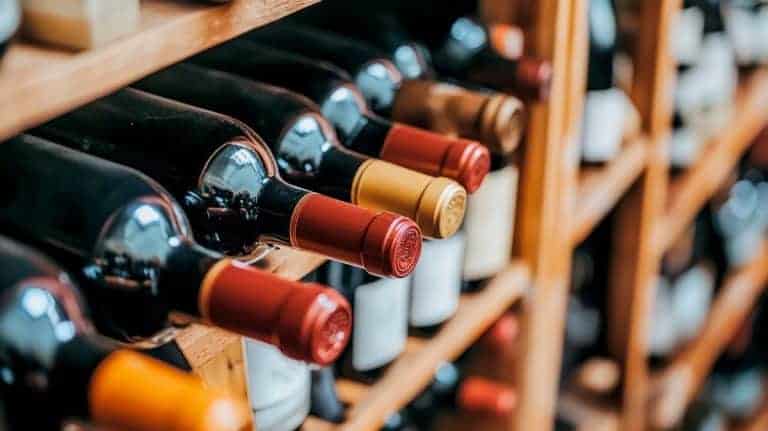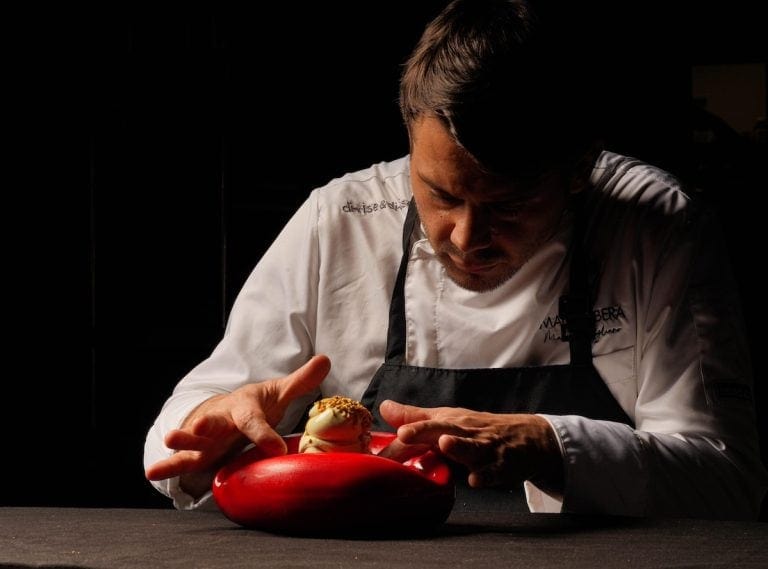We reached out to Corrado Tenace during a particularly hectic time: the days leading up to New Year’s Eve are packed with orders, deliveries, events, and meetings for those like him who specialise in oysters. These delicacies, symbolic of festive celebrations, often make their way to Italian tables during the period between Christmas and New Year’s. For those less familiar, choosing the right oysters can be daunting: which are the best, and how do you recognise them? There’s no single answer, as it depends on the how and when, personal taste, and the moment you decide to buy them. However, there are unmistakable indicators of quality and excellence. To explain what they are, we turned to Tenace, who has been active for years not only in the trade but also in spreading awareness. Not all oysters are created equal.
Small Yet Crucial Tips for Purchasing Oysters
- Order in advance. This isn’t just a whim but a way to ensure a fresher and higher-quality product. A shopkeeper doesn’t purchase a perishable and highly prized product without a guaranteed sale. If they do, it might indicate that their investment isn’t significant or that they’re expecting high profits from excessive markups, which often happens when margins are too (or overly) generous.
- Check the label: The product shouldn’t be older than 7 or 8 days. Also, verify that the size and number of pieces match what’s stated on the label.

Flat or concave?
Differing in shape, flat and concave oysters belong to two different scientific species: one is Ostrea edulis, and the other is Crassostrea gigas. There’s a significant difference between the two: flat oysters, often referred to as Belon, are viviparous, while concave ones are oviparous. In simpler terms, the former release naked larvae into the water (around 100,000), whereas the latter release eggs (tens of millions). The larvae are much more vulnerable and fewer in number compared to the eggs. What does this mean for consumers? Flat oysters are rarer.
The Numbers Matter
What does the number next to the name mean? It indicates the size: the smaller the number, the larger the oyster. A size 0 (or multiple zeros) weighs about 160 grams gross (including water and shell, which account for 75% of the weight), while a size 6 weighs about 45 grams. A size 3, considered intermediate, is around 90 grams gross. Why is it universal? “Universal because it satisfies both beginners and connoisseurs. Beginners, accustomed to swallowing the meat in one big bite, are struck by it, while seasoned eaters with a more instinctive approach can already appreciate the meat’s texture. However, beginners might also do well with a size 6, while a lower size is better for a more advanced palate.”

Shape matters
When closed, an oyster should have a regular teardrop shape, even in profile, resembling a sliced teardrop. The nacre should be beautiful, well-formed, thin yet hard as a diamond. The exterior appearance tells us a lot because the larvae (naissain), once they reach the size of a legume and are ready to form their shells, shape the nacre with its definitive form in the open sea. The deeper they are placed, the slower they grow and the better their shape; nearer the surface—where there’s more light and warmer water—their metabolism differs, causing them to build their shells more quickly but less precisely. “A Fine de Claire is placed nearer the surface, which is why it rarely has a beautifully compact teardrop-shaped shell. It’s generally thinner and more fragile. Spéciales and even more so Pousse en Claire are placed deeper.” That’s why a shell that’s a finger thick and over 10 centimetres long isn’t ideal. “If they’re selling it to you for €7, they’re likely cheating you.”
The fattening process
Once the shell is formed—composed mainly of salt—the focus shifts to fattening the oyster in refining basins (e.g., in the Belon River or the clay-rich areas of the Claires). Just like with meat or tuna, fat is a prized characteristic. During this phase, the shells are placed in highly suitable areas, swept by tides, for varying periods and densities, factors that influence the final product’s characteristics and quality. In the Claire basins, Fine de Claire oysters spend two months with 30 oysters per square metre; Spéciales spend four months with 10 oysters per square metre; and Pousse en Claire, the most prized, spend six months with 2–4 oysters per square metre.
The price
“When a friend asks me how much oysters cost for Christmas, I tell them they should budget at least €2 per oyster for a product that meets quality standards over 12 months.” But that’s the price for the seller. For a medium-sized oyster, size 3, the price for a retailer is about €2.20 including VAT. What about for the consumer? “It depends on whether you’re buying from a shop, wine bar, or restaurant, and the type of establishment it is.” Generally, the restaurant industry follows the rule of tripling the purchase price to ensure fair profits after expenses. “But personally, I advise against this. Some follow my advice, and you can find a good product for around €4.50/5. Others don’t, and prices exceed €6. For an exceptional product like a size 3 Tarbouriech, it’s hard to find one for less than €7, but the quality speaks for itself.”

Opening oysters like a pro
Opening oysters properly means ensuring no fragments of nacre end up in the shell. This isn’t just about aesthetics but also about avoiding unpleasant surprises when chewing. Alternatively, rinsing them in water would remove the merroir (the water characteristics where the oyster grew, akin to terroir in wine). Rule number one is to avoid hurting yourself.

Serving tips
Open them a few minutes beforehand to soften the initial flavour, allowing the more elegant and evolved notes to emerge. Chewing them thoroughly is recommended to fully appreciate their complexity. “I eat them with my fingers and gently press them to release the water. I also open them in advance to drain the water.” For pairing, classic accompaniments are worth trying, especially if the oysters aren’t of the highest quality. Lemon slightly mutes the saltiness, while the classic French pairing—shallots and raspberry vinegar—is strategic: vinegar tames the minerality and brininess, and the shallots add texture to oysters lacking substance.
Tasting
The range of flavours is one of the great virtues of oysters. Primary flavours are tied to salinity, secondary ones to the merroir, ranging from vegetal to forest notes to fruit, and tertiary flavours appear in the best specimens. There’s a rich, fatty sensation and sometimes sweetness, another merit: “I remember eating an extraordinary oyster once. My fingers were sticky, as if I’d touched a sugary drink, from the high sugar content in the meat.” The hallmark of Fine de Claire oysters is their freshness, with a primary flavour of the sea, secondary vegetal notes, and a fun chewiness that’s not overwhelming. Spéciales are marked by elegance: “They are broad and persistent, with primary sea flavours, vegetal notes from the merroir, and tertiary hazelnut notes linked to the fat structure.” Tertiary flavours become more persistent and nuanced in exceptional specimens, matured longer and at lower densities, such as Pousse en Claire.

Seasonality and the miracle of Green Oysters
This is the perfect time to buy oysters, as they have recovered from the summer dormancy phase and are at their best. (These are the famous months with an “r”... don’t be fooled, though: even January in French has an “r.”) “In the best French regions between October and April, small miracles occur, such as the formation of a particular blue phytoplankton, the blue navicula, which thrives especially in the Claire basins of Marenne. Nature doesn’t guarantee the formation of this single-celled algae—it depends on salinity, water temperature, and the specific way light penetrates.” When blue navicula is present in the water, the oyster’s yellowish gills turn green. If you notice greenish hues inside, don’t worry—they’re not spoiled. On the contrary, it’s a mark of quality.
Which to Buy?
Final question: which oysters does Corrado Tenace serve to his family? “First, how many: 24. A dozen would definitely be Pousse en Claire, if I’m lucky enough to find them—I’d want the ones with green gills because that’s the pinnacle. In this season, green oysters are the ones to go for.” And the other dozen? “I’d pick a dozen Italian oysters: San Michele from Puglia and Tarbouriech from Scardovari in the province of Rovigo. They are leading the charge for a movement that’s trying to bring all of Italy along, from Veneto to Sicily.” Because Italy is now one of the leading producers of oysters. But that’s a story for another time.


 US tariffs: here are the Italian wines most at risk, from Pinot Grigio to Chianti Classico
US tariffs: here are the Italian wines most at risk, from Pinot Grigio to Chianti Classico "With U.S. tariffs, buffalo mozzarella will cost almost double. We're ruined." The outburst of an Italian chef in Miami
"With U.S. tariffs, buffalo mozzarella will cost almost double. We're ruined." The outburst of an Italian chef in Miami "With US tariffs, extremely high risk for Italian wine: strike deals with buyers immediately to absorb extra costs." UIV’s proposal
"With US tariffs, extremely high risk for Italian wine: strike deals with buyers immediately to absorb extra costs." UIV’s proposal Meloni: "Tariffs? If necessary, there will be consequences. Heavy impact on agri-food sector"
Meloni: "Tariffs? If necessary, there will be consequences. Heavy impact on agri-food sector" The Government honours the greats of Italian cuisine, from Bottura to Pepe. Massari: "Thank you, Meloni, the only one who listened to us"
The Government honours the greats of Italian cuisine, from Bottura to Pepe. Massari: "Thank you, Meloni, the only one who listened to us"






